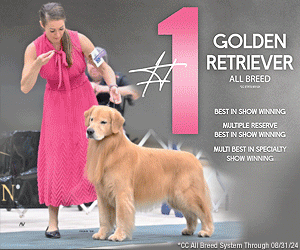Health Testing – Education or Elimination?
Click here to read the complete article
by Pilar Kuhn
 Recently, the Humane Society of the United States boasted that 87% of all pets in homes in America have been spayed or neutered. That means that a mere 13% of animals are of breeding capability. In each and every breed of dog there are health tests recommended or required by parent clubs and fellow breeders before considering a dog or bitch for carrying on and taking their foray into the whelping box. The Orthopedic Foundation for Animals works diligently “to promote the health and welfare of companion animals through a reduction in the incidence of genetic disease”. Breeders use their collective information for health research. We use their website to share with puppy buyers the health history behind the puppies they take into their homes.
Recently, the Humane Society of the United States boasted that 87% of all pets in homes in America have been spayed or neutered. That means that a mere 13% of animals are of breeding capability. In each and every breed of dog there are health tests recommended or required by parent clubs and fellow breeders before considering a dog or bitch for carrying on and taking their foray into the whelping box. The Orthopedic Foundation for Animals works diligently “to promote the health and welfare of companion animals through a reduction in the incidence of genetic disease”. Breeders use their collective information for health research. We use their website to share with puppy buyers the health history behind the puppies they take into their homes.
Last summer we took four littermates for radiographs on their hips and elbows on the same day. For one reason or another, three of the four littermates would not get a “normal” elbow rating from OFA. I was more than surprised. Both parents had normal elbows. All of the grandparents had normal elbows. So why would we expect anything other than “normal” for these offspring? I called a few of my colleagues on the way home and they asked me, “What do these dogs have that could carry forward to improve the breed? How are their hips? Their hearts? Their eyes? Their coats? Their temperament?” I had no hesitation. They all possessed something important that we felt our breed needs to survive. Now we had knowledge; and knowledge is power. Whereas some breeders would choose to spay or neuter these animals and remove them from the gene pool, with our colleagues’ blessings, we chose to keep them in the gene pool and sought out mates that had fully-passed elbow tests.
Just before Westminster this year, OFA posted on Facebook a small blurb and write-up regarding keeping dogs in the gene pool and it used hip tests as an example. “In breeds where the gene pool is limited – that is, breeds that do not have a vast number of breeding animals available and/or those that lack diversity in the pedigrees of available breeding animals – utilizing the dog with Fair hips, assuming the dog is of good or even average quality, is far preferable to further limiting the gene pool by taking the dog out of circulation. One would, naturally, want to ‘breed up’ by using the dog with Fair hips to one with Good or Excellent hips, and then screening the offspring and, in future generations, going forward with the ones that have better hip ratings,” OFA wrote. I recently took the time to talk with Dr. Keller at OFA regarding this very matter and concept of “breeding up”. Together, we looked at their online educational pieces. In case you weren’t aware, there is a document on their website titled, “The Use of Health Databases and Selective Breeding”. http://www.offa.org/pdf/monograph_2012_web.pdf
One of the graphs we reviewed is the Hip Dysplasia graph on Page 9 of the document. It shows the statistical percentage of around 500,000 canines tested and how with each breeding combination, there is a percentage of potential dysplastic progeny. We also reviewed the elbow dysplasia graph on Page 33 and saw similar findings, but based on a much smaller amount of progeny tested – 67,599. Do these findings mean that a dog that doesn’t have a hip or elbow pass will only pass bad hips or elbows? No. But with that information, a breeder can make a choice about what the overall holistic contributions a dog makes for that breed and search for a mate to improve upon the next generation. One of the best ways to assure the health of a breed is to keep the gene pool from shrinking.
Some people have a “slash and burn” mentality about a dog not passing some aspect of a health test. If the two parents have “normal” results but produce some offspring with abnormal results, these people would not only eliminate the offspring, but the parents, the grandparents, and the great-grandparents. This mentality would swiftly wipe out any potential breeding stock. Five years ago I attended a short presentation about the DNA Breeding Tool from Mars Veterinary called Optimal Selection (now in partnership with Genoscope). Veterinarian and geneticist Dr. Angela M. Hughes, DVM worked to bring this tool to the public. I have had the opportunity to speak with her on several occasions about the various advances she and her team continue to make and she was more than excited to share information about their case study with the Dandie Dinmont. The breed was facing extinction. Their gene pool was miniscule. Through DNA comparisons, the geneticists found that the very dogs long-time breeders were avoiding were the ones they needed to get back into their pedigrees to improve the overall health of the breed. Rather than eliminating some dogs, they chose to use them and, in one generation, broadened the gene pool and improved the longevity of the breed.
After spending years caring for, loving, exhibiting, and paying for health tests on a dog or dogs, it begs one to ask the questions, “Why do the health testing if you just decide to eliminate them from the gene pool? Don’t we do health testing to have the information and education to make the best choices for moving the breed forward?” I am thankful we have veterinarians and geneticists helping us make the best decisions we can for the longevity of our breeds. We could health test all breeds into extinction. The Humane Society of the United States would love that. Some people are eliminating animals from the gene pool that may offer something much more far-reaching and we should consider trying to increase that “breeding capability percentage” back up beyond 13%. And, per OFA, the concept of “breeding up” is a reality. The long and the short of it is health testing should be about education, not elimination.
Short URL: http://caninechronicle.com/?p=102151
Comments are closed











